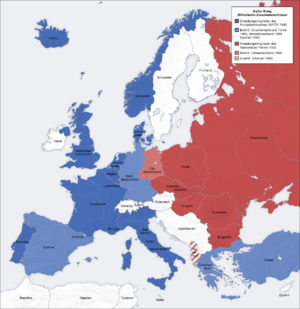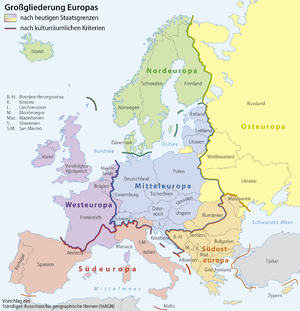Eastern Europe
![]()
This article deals with the geographical term. For the magazine, see Eastern Europe (magazine).
Eastern Europe refers to the eastern part of Europe adjacent to Central Europe. A more specific definition of Eastern Europe depends on the context in which the term is used:
- In a geographical sense, Eastern Europe includes not only the European part of Russia and the northwestern part of Kazakhstan, but also the central and eastern part of Ukraine, while its extreme southwest (Carpathian Ukraine, Bukovina and Galicia) is often assigned to Central Europe. The very largest part of Belarus is also included. However, much of Eastern Europe lies north of Central Europe, with cities such as Saint Petersburg ("Venice of the North"), Novgorod, and Murmansk lying further north than many Scandinavian cities. Northwestern Russia was usually counted as part of Northern Europe until the mid-19th century. The most geographically correct term for this area is Northeastern Europe. The defining landform in Eastern Europe is the vast Eastern European Plain, which extends to, among other places, the Ural Mountains separating Eastern Europe from Asia and abuts the icy Arctic Ocean to the north. The eastern border of Eastern Europe with Asia is not clearly defined, especially in the southeast between the Urals and the Black Sea.
- In the historical sense, Eastern Europe refers to Ukraine, the European part of Russia, Belarus and the Republic of Moldova. Occasionally, the Caucasian countries of Georgia, Armenia and, conditionally, Azerbaijan are also seen as part of Eastern Europe. By Christian Giordano and other scholars, one of the six historical regions of Europe is called "Eastern Europe." The Eastern European countries are historically and culturally largely influenced by the Orthodox Church (Islamic Azerbaijan excepted) and were - in contrast to the Ottoman-dominated Balkans - under the rule of the Russian Empire. Like the Balkan countries, the countries of Eastern Europe were for a long time backward agricultural states (cf.: Intermediate Europe) and had no or only a limited share in the social developments of the Renaissance, Reformation and Enlightenment of the Western world. The fact that communism was able to assert itself from 1917 onward, first in Russia and later, as a result of World War II, in other countries as well, and that it was able to hold its ground for several decades, was a rather curious development that contradicted the expectations of Marxism, even though the backwardness of the greater region may have offered a somewhat favorable starting position for an independent socialist approach to modernization.
- In the ethnic, linguistic and cultural sense, Eastern Europe refers to the part of Europe inhabited by Slavic peoples. However, this simplified classification is criticized because, on the one hand, the eastern part of Germany was also inhabited by Slavs for a long time and partly still is today (see Sorbs) and, on the other hand, countries like Hungary, Romania, Moldova and Estonia, as well as - depending on the definition - Lithuania and Latvia (see Balto-Slavic hypothesis) are completely disregarded as non-Slavic countries surrounded by Slavic peoples.
- In the political sense, Eastern Europe referred to the European Eastern Bloc countries during the Cold War.
The Eastern European and the East-Central European countries are often considered together for political reasons. In EU jargon, the abbreviation for this is CEEC.
- In the statistical sense since 1945 at the earliest of the United Nations, Eastern Europe includes: Bulgaria, the Republic of Moldova, Romania, Russia, Slovakia, Ukraine, Hungary, Poland, the Czech Republic and Belarus. The Baltic states already belong to Northern Europe.
- In the linguistic-geographical sense of the United Nations, the Department for Eastern Europe, North and Central Asia includes the following states: Armenia, Azerbaijan, Bulgaria, Kyrgyzstan, Mongolia, Russia, Ukraine, Uzbekistan, and Belarus.
Eastern Europe has been a central research area of Ostforschung, which began in the eastern part of Germany. Many Eastern European countries use Eastern European Time (EET)

The former Eastern bloc countries in red

Proposal of the Standing Committee on Geographical Names for the Delimitation of Eastern Europe
See also
- Specialized Information Service East, East-Central and Southeast Europe
Search within the encyclopedia